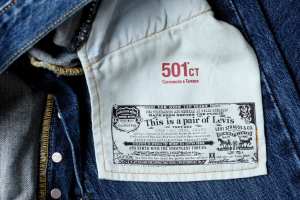
A denim company may be one of the last places one would expect to find innovation. How much have jeans really changed since the inception of Levi’s more than 150 years ago?
The answer: quite a lot.
With more than $4.9 billion in revenue in 2017, Levi Strauss & Co.. continues to earn their reputation as one of the most groundbreaking clothing companies in the world.
Through Eureka Labs, the company’s innovation arm, the denim empire has consistently transformed with changing tastes and trends, and is not shy about completely re-vamping everything from product manufacturing practices to the customer experience.
Below is a sample of the ways Levi’s is staying on the cutting-edge of tech innovation.
For more retail innovation see how Nike is weaving innovation into their strategy
Improving Safety With Lasers
For over 30 years, Levi Strauss and most other clothing manufacturers have resorted to using hand-finishing and caustic chemical processes that can be harmful to factory employees.
Levi’s is using innovation to take action on factory safety and productivity at the same time. The company has pledged to reduce its discharge of hazardous chemicals to zero and implement an entirely new design system by the year 2020.
One tech solution their innovation lab has cooked up to reach this goal is using laser-based design systems to create the trendy finishing that would have otherwise required thousands of different chemicals.
Levi’s is using innovation to take action on factory safety and productivity at the same time. Click To TweetBut beyond cutting down on hazardous waste, this system makes the Levi’s manufacturing process much more efficient. For some styles, the finishing process was reduced from 20-30 steps down to just a handful.
The lasers can create the same styles that the chemicals did such as fading and tearing, but in a fraction of the time and in a much safer way.
Although lasers have been used before in clothing design, where Levi Strauss is breaking ground here is in the size, complexity and breadth of their new laser finishing system.
Teaming Up With Tech Giants
Let’s say you go to the store looking to buy a pair of jeans. They have every size but yours, which is strange because you checked online and it said they had three in stock. You go ask the clerk if the pants could be anywhere else, but he doesn’t know. He goes to “check in the back” but comes out empty-handed.

That kind of lost sale is extremely frustrating for the consumer and all too common in the retail industry.
Levi Strauss, in conjunction with Intel, hopes to have an answer. They are testing a real-time in-store tracking system for their products that will make product management and organization much more customer-friendly.
Learn why it pays to innovate your customer experience and how you can get started
Through a combination of low-cost radio frequency identification (RFID) tags, sensors, Intel gateways and sophisticated cloud-computing, Levi’s and Intel have created a system that can alert store clerks where any given item is at all times.

They can also instruct the system to send prioritize alerts. For example, when a specific item is out of stock, such as the last pair of a certain size of jeans, that will take priority over less urgent alerts like a shirt that is fully stocked.
Ultimately, this digital transformation has the potential to create a cycle of continuous innovation where digital transformation leads to better customer experiences, which provide data that improves cross-company processes, which then leads to more digital transformation, and so on.
Changing Yet Staying the Same
One of the things that draws people to Levi’s products is consistency. Everyone knows how a pair of jeans are supposed to look and feel, and they crave that familiarity.
However, the fashion industry is constantly shifting and changing. So, how does a company reconcile their tradition in an industry that values change and trends?
Innovation helps Levi Strauss & Co. capitalize on the familiarity and nostalgia of their brand while also delivering a product that plays to the public’s thirst for the new and the different.
Learn how a Chief Innovation Officer is taking Ralph Lauren from classic to cutting-edge
One of the biggest trends in the clothing industry right now is performance. The popularity of athleisure has boomed because it allows people to easily transition from exercising to socializing and back again.

Levi’s can’t necessarily excel in making yoga pants, nor do they really want to. But what they can and did do is can change their manufacturing techniques to make a product that feels like a familiar pair of jeans but that has an added level of performance that people wouldn’t normally associate with denim.
For example, they devised a method of weaving their fabric that increases moisture wicking and insulation while still maintaining a 100% cotton product with the look and feel of real denim.
This proprietary process involves weaving in polyester fibers along with the cotton threads, and then using a process to dissolve the polyester so only the cotton remains.
Sustaining Their Future
Levi Strauss & Co. understands the impact a company of their size has on the world and the responsibilities that come along with it — from their employees to their consumers to the environment, and beyond.
They have spearheaded numerous sustainability measures meant to protect the future people inside and outside of the Levi’s enterprise, and they understand the cost of innovation.
Innovation doesn’t always come cheap, but without it your company will fall behind.
Can You Afford Not to Innovate? The 3 Pitfalls of Forgoing Innovation
Innovating is the only way to future-proof your business and to ensure that your vision continues long after the world changes. Levi Strauss & Co. doesn’t shy away from totally transforming the way they do business, and their focus on the future will help sustain their company’s longevity for years to come.